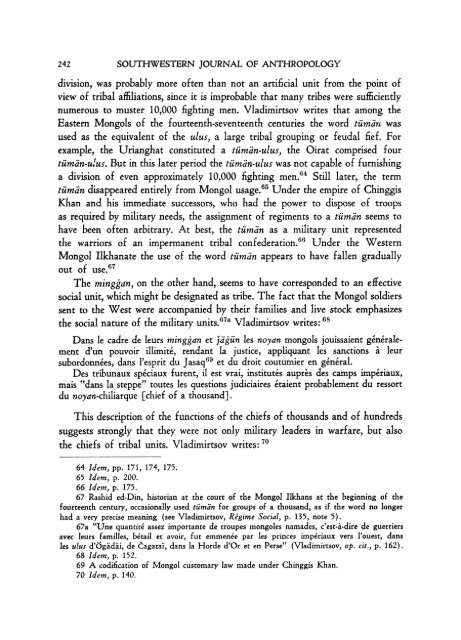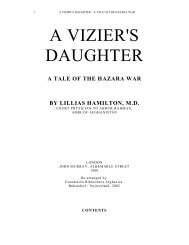The Inquiry into the History of the Hazara Mongols of ... - Hazara.net
The Inquiry into the History of the Hazara Mongols of ... - Hazara.net
The Inquiry into the History of the Hazara Mongols of ... - Hazara.net
You also want an ePaper? Increase the reach of your titles
YUMPU automatically turns print PDFs into web optimized ePapers that Google loves.
242<br />
SOUTHWESTERN JOURNAL OF ANTHROPOLOGY<br />
division, was probably more <strong>of</strong>ten than not an artificial unit from <strong>the</strong> point <strong>of</strong><br />
view <strong>of</strong> tribal affiliations, since it is improbable that many tribes were sufficiently<br />
numerous to muster 10,000 fighting men. Vladimirtsov writes that among <strong>the</strong><br />
Eastern <strong>Mongols</strong> <strong>of</strong> <strong>the</strong> fourteenth-seventeenth centuries <strong>the</strong> word tiimai was<br />
used as <strong>the</strong> equivalent <strong>of</strong> <strong>the</strong> ulus, a large tribal grouping or feudal fief. For<br />
example, <strong>the</strong> Urianghat constituted a tum'dn-ulus, <strong>the</strong> Oirat comprised four<br />
tuiimn-ulus. But in this later period <strong>the</strong> tiimin-ulus was not capable <strong>of</strong> furnishing<br />
a division <strong>of</strong> even approximately 10,000 fighting men.64 Still later, <strong>the</strong> term<br />
tiimdn disappeared entirely from Mongol usage.65 Under <strong>the</strong> empire <strong>of</strong> Chinggis<br />
Khan and his immediate successors, who had <strong>the</strong> power to dispose <strong>of</strong> troops<br />
as required by military needs, <strong>the</strong> assignment <strong>of</strong> regiments to a tiiman seems to<br />
have been <strong>of</strong>ten arbitrary. At best, <strong>the</strong> tiimdn as a military unit represented<br />
<strong>the</strong> warriors <strong>of</strong> an impermanent tribal confederation.6 Under <strong>the</strong> Western<br />
Mongol Ilkhanate <strong>the</strong> use <strong>of</strong> <strong>the</strong> word tiiman appears to have fallen gradually<br />
out <strong>of</strong> use.67<br />
<strong>The</strong> minggan, on <strong>the</strong> o<strong>the</strong>r hand, seems to have corresponded to an effective<br />
social unit, which might be designated as tribe. <strong>The</strong> fact that <strong>the</strong> Mongol soldiers<br />
sent to <strong>the</strong> West were accompanied by <strong>the</strong>ir families and live stock emphasizes<br />
<strong>the</strong> social nature <strong>of</strong> <strong>the</strong> military units.67a Vladimirtsov writes: 68<br />
Dans le cadre de leurs minggan et ]iagiin les noyan mongols jouissaient generalement<br />
d'un pouvoir illimite, rendant la justice, appliquant les sanctions a leur<br />
subordonnees, dans l'esprit du Jasaq69 et du droit coutumier en general.<br />
Des tribunaux speciaux furent, il est vrai, institutes aupres des camps imperiaux,<br />
mais "dans la steppe" toutes les questions judiciaires etaient probablement du ressort<br />
du noyan-chiliarque [chief <strong>of</strong> a thousand].<br />
This description <strong>of</strong> <strong>the</strong> functions <strong>of</strong> <strong>the</strong> chiefs <strong>of</strong> thousands and <strong>of</strong> hundreds<br />
suggests strongly that <strong>the</strong>y were not only military leaders in warfare, but also<br />
<strong>the</strong> chiefs <strong>of</strong> tribal units. Vladimirtsov writes: 70<br />
64 Idem, pp. 171, 174, 175.<br />
65 Idem, p. 200.<br />
66 Idem, p. 175.<br />
67 Rashid ed-Din, historian at <strong>the</strong> court <strong>of</strong> <strong>the</strong> Mongol Ilkhans at <strong>the</strong> beginning <strong>of</strong> <strong>the</strong><br />
fourteenth century, occasionally used tuman for groups <strong>of</strong> a thousand, as if <strong>the</strong> word no longer<br />
had a very precise meaning (see Vladimirtsov, Regime Social, p. 135, note 5).<br />
67a "Une quantite assez importante de troupes mongoles namades, c'est-a-dire de guerriers<br />
avec leurs families, betail et avoir, fut emmen6e par les princes impiriaux vers l'ouest, dans<br />
les ulus d'bgadai, de Cagatai, dans la Horde d'Or et en Perse" (Vladimirtsov, op. cit., p. 162).<br />
68 Idem, p. 152.<br />
69 A codification <strong>of</strong> Mongol customary law made under Chinggis Khan.<br />
70 Idem, p. 140.



